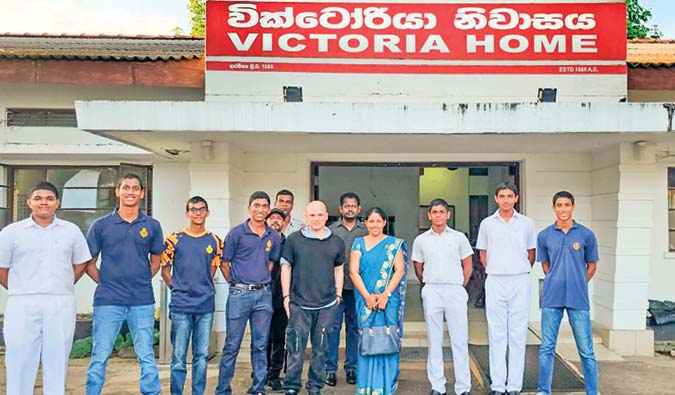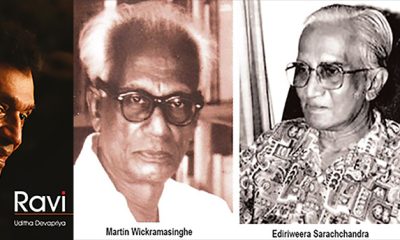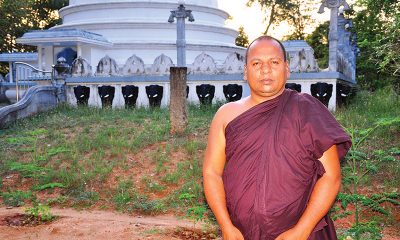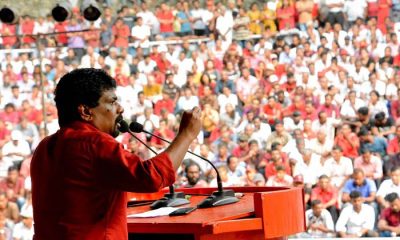Features
Royal College Interact surges ahead

By Uditha Devapriya
Interactions are about connections. Connections are not always about commonalities. After all, it is not just commonalities that are celebrated, it is also differences. There are many ways of celebrating differences, many ways of affirming them. The Interact Movement in Sri Lanka is now almost 60 years old. The Interact Club of Royal College, established in 1965, is Sri Lanka’s oldest functioning such society, and Asia’s third oldest. Through the years it has picked on new ways of celebrating differences. In doing so it has opened its members to the world beyond their homes, a world that remains much less privileged.
Interactions are also about relevance. There is no point organising this project or that if it is out of step with the times. But there is no point in being relevant if the same thing is done and repeated every year. The Interact Club of Royal College has a series of projects that it commits to every year. These target specific communities and social groups. While going ahead with them, however, it also devotes time and space to new initiatives. These have helped it revive the movement, at a time when the idea of voluntarism has become limited to flowery cosmetics. The Club has had no choice there: if it is to live up to its name, it has to go beyond mere show. It has to embrace the new without neglecting the old.
COVID-19 did not really disrupt the work of organisations like Interact, but it did force them to think of new ways of achieving their objectives. For close to two years, if not more, these organisations were forced to shift to Zoom and social media. With an economic crisis and a fuel shortage around the corner, they had no choice but to go online. 2023, however, spelt out something totally different. With a new board of directors – the Interact Club calendar runs from July of one year to June of the following – the Royal College Interact Club decided to do something new and different. Because of the pandemic, Interact Club projects had become restricted to visiting underprivileged communities and donating money and rations to homes and hospitals. This year’s Board wanted to go beyond that.
Out of their desire to do something different, the Board came up with Surge, a series of projects revolving around the idea of giving back to deprived communities while going beyond just handing over money and rations.
The Interact Club at Royal, like Interact Clubs everywhere else, is divided into five divisions or departments: Community Service, Finance, Green Life, Club Service, and International Understanding. Each division has a director, known as an Avenue Director. Though they have distinct aims, divisional projects are open to all Club members.
This year’s Avenue Director for Community Service Projects, Buda Cumaratunga, wanted not just to revive the Interact Club culture which had prevailed before the pandemic, but to breathe new life into existing projects and bring out a new meaning for the Club: in short, to make the College Interact Club more interesting, innovative, and relevant. The team zeroed in on Surge as their launching pad in this regard.
“Our aim for Surge was to go beyond field visits. Surge was not a new-new initiative: we had organised it many times before. But it lacked the vitality that it demanded. For that reason, I wanted us to go out, to interact with other communities, to experience and absorb their feelings, wishes, anxieties, and aspirations. So we brainstormed for new ideas and I must say our team came up with some pretty interesting pitches. We did not have a set code for what we wanted to do. But we knew we had to break out from the past.”
The Committee thus got together. Chaired by Buda, it included Radeesh Manoharan, Sahan Agalawatte, Hansana Jayawardena, Tehan Gunathilake, Lithum Karunasena, Dinuka Rajapaksha, and Sasen Premaratne. With the support of parents, school administrators, and well-wishers, they endeavoured to surge ahead.
On May 15 the Committee visited the Mihindu Seth Madura, a resort for disabled war veterans. “We donated some much-needed UPS machines, though we ensured we did not leave it at that and organised a tea and a ranaviru gee session.” Two months later, on July 8, they visited the Cancer Hospital. Two days later they went to the Diabetic and Endocrine Unit at the National Hospital. On July 18 they visited the Gamini Matha Elders’ Home, and on the next day they visited the Victoria Home in Rajagiriya. The sixth phase, on July 25, saw the team make donations to Talahena Maha Vidyalaya, while in the seventh and last phase they donated uniforms to some students at Royal College.
At first glance, these appear to be typical “volunteer society” projects, hardly distinguishable from those for which Interact Clubs have gained a reputation. What made these projects memorable was not so much what was done as how it was done and where. The ranaviru gee session at the Mihindu Seth Madura provided a template for the kind of interactions Club members aimed at in their other visits. That, however, was not to be with their next two projects. “We could not interact with patients at the Cancer and National Hospitals because of hygiene concerns.” Once those phases were done, a well-wisher of the Interact Club, Shannon Raymond, suggested that the members visit Victoria Home.
Founded in 1888 to commemorate the Coronation Jubilee of Queen Victoria, the Victoria Home for Incurables was planned as a home for some of society’s most ostracised communities, a safe haven for physically and mentally handicapped patients who had been neglected or abandoned by their families.
“Mr Raymond told us that we needed to talk and make friends with the residents. However, he warned us to prepare ourselves. It was not a typical elders’ home or orphanage type establishment. It was a far cry from the kind of places we visited. Having said that, we felt confident enough to go and do what we could for these people.”
Fortunately, the day lasted well enough, involving music, merriment, and interaction. The patients had not experienced a visit this informal, still less one with a calypso band. While some of the students may have been daunted at first, doubtful of what sort of impact they would have on the patients, they soon felt confident enough to go ahead. The patients for their part, not surprisingly, felt happy. “They knew we were doing something different, and they responded accordingly.” Somewhere down the line the team became more than just visitors, they became close friends of the residents. “Our fears vanished at once. They loved the music and loved that we were talking with them.”
After they broke the proverbial ice, the Victoria Home phase became the highlight of the whole project. This, of course, is hardly surprising. It is easy to make donations and feel good and smug about it, but harder to break through to and establish common ground with the people you are trying to help. Not surprisingly, the Interact Club received the endorsement and support of the school staff, including administrative officials.
“We were helped a lot by our former principal Mr R. M. M. Ratnayake and current principal Mr Thilak Waththuhewa. Mr M. V. S. Gunathilake, our Deputy Principal, intervened as well, as did Mr Chandana Liyanage and Mr Jaliya Yasarathna, our former and current Assistant Principals and Senior Masters in Charge of Clubs and Societies respectively, and Mr M. A. M. Riyaz, our Senior Games Master. Ms Iresha Gunethilaka, Ms Inoka Perera, and Ms Geethika Ariyawansa, Staff Advisors to the Interact Club, and Rtn. Majeed Cader and Rtn. Sureka Amerasinghe, Rotary Advisors, also guided us throughout.”
The team also remembered this year’s Interact Committee: “Our Club President Talal Sabry, Vice President Sanuka Wanasingha, Secretary Niven Dorabawila, and Treasurer Sasindu Perera, along with our Divisional Directors: Charith Ahangama in Club Service, Aaqib Mohideen in Finance, Charith Ahangama in Club Service, Dinindu Salgado in Green Life, and Shankarshana Ratnasabhapathy in International Understanding.”
Interactions, like I said, are about connections, and connections are not always built on commonalities. In that sense clubs like Interact have two main objectives: on the one hand they push their members to confront and interact with other communities, to experience the world those communities come from. On the other hand, they occupy members with projects and inculcate organisational skills in them. With Surge, the Interact Club of Royal College has chosen to do something new, and to break new ground, and in doing so to make itself more relevant, not just to the school, but to society at large.
The writer is an international relations analyst, independent researcher, and freelance columnist who can be reached at .
Features
The heart-friendly health minister

by Dr Gotabhya Ranasinghe
Senior Consultant Cardiologist
National Hospital Sri Lanka
When we sought a meeting with Hon Dr. Ramesh Pathirana, Minister of Health, he graciously cleared his busy schedule to accommodate us. Renowned for his attentive listening and deep understanding, Minister Pathirana is dedicated to advancing the health sector. His openness and transparency exemplify the qualities of an exemplary politician and minister.
Dr. Palitha Mahipala, the current Health Secretary, demonstrates both commendable enthusiasm and unwavering support. This combination of attributes makes him a highly compatible colleague for the esteemed Minister of Health.
Our discussion centered on a project that has been in the works for the past 30 years, one that no other minister had managed to advance.
Minister Pathirana, however, recognized the project’s significance and its potential to revolutionize care for heart patients.
The project involves the construction of a state-of-the-art facility at the premises of the National Hospital Colombo. The project’s location within the premises of the National Hospital underscores its importance and relevance to the healthcare infrastructure of the nation.
This facility will include a cardiology building and a tertiary care center, equipped with the latest technology to handle and treat all types of heart-related conditions and surgeries.
Securing funding was a major milestone for this initiative. Minister Pathirana successfully obtained approval for a $40 billion loan from the Asian Development Bank. With the funding in place, the foundation stone is scheduled to be laid in September this year, and construction will begin in January 2025.
This project guarantees a consistent and uninterrupted supply of stents and related medications for heart patients. As a result, patients will have timely access to essential medical supplies during their treatment and recovery. By securing these critical resources, the project aims to enhance patient outcomes, minimize treatment delays, and maintain the highest standards of cardiac care.
Upon its fruition, this monumental building will serve as a beacon of hope and healing, symbolizing the unwavering dedication to improving patient outcomes and fostering a healthier society.We anticipate a future marked by significant progress and positive outcomes in Sri Lanka’s cardiovascular treatment landscape within the foreseeable timeframe.
Features
A LOVING TRIBUTE TO JESUIT FR. ALOYSIUS PIERIS ON HIS 90th BIRTHDAY

by Fr. Emmanuel Fernando, OMI
Jesuit Fr. Aloysius Pieris (affectionately called Fr. Aloy) celebrated his 90th birthday on April 9, 2024 and I, as the editor of our Oblate Journal, THE MISSIONARY OBLATE had gone to press by that time. Immediately I decided to publish an article, appreciating the untiring selfless services he continues to offer for inter-Faith dialogue, the renewal of the Catholic Church, his concern for the poor and the suffering Sri Lankan masses and to me, the present writer.
It was in 1988, when I was appointed Director of the Oblate Scholastics at Ampitiya by the then Oblate Provincial Fr. Anselm Silva, that I came to know Fr. Aloy more closely. Knowing well his expertise in matters spiritual, theological, Indological and pastoral, and with the collaborative spirit of my companion-formators, our Oblate Scholastics were sent to Tulana, the Research and Encounter Centre, Kelaniya, of which he is the Founder-Director, for ‘exposure-programmes’ on matters spiritual, biblical, theological and pastoral. Some of these dimensions according to my view and that of my companion-formators, were not available at the National Seminary, Ampitiya.
Ever since that time, our Oblate formators/ accompaniers at the Oblate Scholasticate, Ampitiya , have continued to send our Oblate Scholastics to Tulana Centre for deepening their insights and convictions regarding matters needed to serve the people in today’s context. Fr. Aloy also had tried very enthusiastically with the Oblate team headed by Frs. Oswald Firth and Clement Waidyasekara to begin a Theologate, directed by the Religious Congregations in Sri Lanka, for the contextual formation/ accompaniment of their members. It should very well be a desired goal of the Leaders / Provincials of the Religious Congregations.
Besides being a formator/accompanier at the Oblate Scholasticate, I was entrusted also with the task of editing and publishing our Oblate journal, ‘The Missionary Oblate’. To maintain the quality of the journal I continue to depend on Fr. Aloy for his thought-provoking and stimulating articles on Biblical Spirituality, Biblical Theology and Ecclesiology. I am very grateful to him for his generous assistance. Of late, his writings on renewal of the Church, initiated by Pope St. John XX111 and continued by Pope Francis through the Synodal path, published in our Oblate journal, enable our readers to focus their attention also on the needed renewal in the Catholic Church in Sri Lanka. Fr. Aloy appreciated very much the Synodal path adopted by the Jesuit Pope Francis for the renewal of the Church, rooted very much on prayerful discernment. In my Religious and presbyteral life, Fr.Aloy continues to be my spiritual animator / guide and ongoing formator / acccompanier.
Fr. Aloysius Pieris, BA Hons (Lond), LPh (SHC, India), STL (PFT, Naples), PhD (SLU/VC), ThD (Tilburg), D.Ltt (KU), has been one of the eminent Asian theologians well recognized internationally and one who has lectured and held visiting chairs in many universities both in the West and in the East. Many members of Religious Congregations from Asian countries have benefited from his lectures and guidance in the East Asian Pastoral Institute (EAPI) in Manila, Philippines. He had been a Theologian consulted by the Federation of Asian Bishops’ Conferences for many years. During his professorship at the Gregorian University in Rome, he was called to be a member of a special group of advisers on other religions consulted by Pope Paul VI.
Fr. Aloy is the author of more than 30 books and well over 500 Research Papers. Some of his books and articles have been translated and published in several countries. Among those books, one can find the following: 1) The Genesis of an Asian Theology of Liberation (An Autobiographical Excursus on the Art of Theologising in Asia, 2) An Asian Theology of Liberation, 3) Providential Timeliness of Vatican 11 (a long-overdue halt to a scandalous millennium, 4) Give Vatican 11 a chance, 5) Leadership in the Church, 6) Relishing our faith in working for justice (Themes for study and discussion), 7) A Message meant mainly, not exclusively for Jesuits (Background information necessary for helping Francis renew the Church), 8) Lent in Lanka (Reflections and Resolutions, 9) Love meets wisdom (A Christian Experience of Buddhism, 10) Fire and Water 11) God’s Reign for God’s poor, 12) Our Unhiddden Agenda (How we Jesuits work, pray and form our men). He is also the Editor of two journals, Vagdevi, Journal of Religious Reflection and Dialogue, New Series.
Fr. Aloy has a BA in Pali and Sanskrit from the University of London and a Ph.D in Buddhist Philosophy from the University of Sri Lankan, Vidyodaya Campus. On Nov. 23, 2019, he was awarded the prestigious honorary Doctorate of Literature (D.Litt) by the Chancellor of the University of Kelaniya, the Most Venerable Welamitiyawe Dharmakirthi Sri Kusala Dhamma Thera.
Fr. Aloy continues to be a promoter of Gospel values and virtues. Justice as a constitutive dimension of love and social concern for the downtrodden masses are very much noted in his life and work. He had very much appreciated the commitment of the late Fr. Joseph (Joe) Fernando, the National Director of the Social and Economic Centre (SEDEC) for the poor.
In Sri Lanka, a few religious Congregations – the Good Shepherd Sisters, the Christian Brothers, the Marist Brothers and the Oblates – have invited him to animate their members especially during their Provincial Congresses, Chapters and International Conferences. The mainline Christian Churches also have sought his advice and followed his seminars. I, for one, regret very much, that the Sri Lankan authorities of the Catholic Church –today’s Hierarchy—- have not sought Fr.
Aloy’s expertise for the renewal of the Catholic Church in Sri Lanka and thus have not benefited from the immense store of wisdom and insight that he can offer to our local Church while the Sri Lankan bishops who governed the Catholic church in the immediate aftermath of the Second Vatican Council (Edmund Fernando OMI, Anthony de Saram, Leo Nanayakkara OSB, Frank Marcus Fernando, Paul Perera,) visited him and consulted him on many matters. Among the Tamil Bishops, Bishop Rayappu Joseph was keeping close contact with him and Bishop J. Deogupillai hosted him and his team visiting him after the horrible Black July massacre of Tamils.
Features
A fairy tale, success or debacle

Sri Lanka-Singapore Free Trade Agreement
By Gomi Senadhira
senadhiragomi@gmail.com
“You might tell fairy tales, but the progress of a country cannot be achieved through such narratives. A country cannot be developed by making false promises. The country moved backward because of the electoral promises made by political parties throughout time. We have witnessed that the ultimate result of this is the country becoming bankrupt. Unfortunately, many segments of the population have not come to realize this yet.” – President Ranil Wickremesinghe, 2024 Budget speech
Any Sri Lankan would agree with the above words of President Wickremesinghe on the false promises our politicians and officials make and the fairy tales they narrate which bankrupted this country. So, to understand this, let’s look at one such fairy tale with lots of false promises; Ranil Wickremesinghe’s greatest achievement in the area of international trade and investment promotion during the Yahapalana period, Sri Lanka-Singapore Free Trade Agreement (SLSFTA).
It is appropriate and timely to do it now as Finance Minister Wickremesinghe has just presented to parliament a bill on the National Policy on Economic Transformation which includes the establishment of an Office for International Trade and the Sri Lanka Institute of Economics and International Trade.
Was SLSFTA a “Cleverly negotiated Free Trade Agreement” as stated by the (former) Minister of Development Strategies and International Trade Malik Samarawickrama during the Parliamentary Debate on the SLSFTA in July 2018, or a colossal blunder covered up with lies, false promises, and fairy tales? After SLSFTA was signed there were a number of fairy tales published on this agreement by the Ministry of Development Strategies and International, Institute of Policy Studies, and others.
However, for this article, I would like to limit my comments to the speech by Minister Samarawickrama during the Parliamentary Debate, and the two most important areas in the agreement which were covered up with lies, fairy tales, and false promises, namely: revenue loss for Sri Lanka and Investment from Singapore. On the other important area, “Waste products dumping” I do not want to comment here as I have written extensively on the issue.
1. The revenue loss
During the Parliamentary Debate in July 2018, Minister Samarawickrama stated “…. let me reiterate that this FTA with Singapore has been very cleverly negotiated by us…. The liberalisation programme under this FTA has been carefully designed to have the least impact on domestic industry and revenue collection. We have included all revenue sensitive items in the negative list of items which will not be subject to removal of tariff. Therefore, 97.8% revenue from Customs duty is protected. Our tariff liberalisation will take place over a period of 12-15 years! In fact, the revenue earned through tariffs on goods imported from Singapore last year was Rs. 35 billion.
The revenue loss for over the next 15 years due to the FTA is only Rs. 733 million– which when annualised, on average, is just Rs. 51 million. That is just 0.14% per year! So anyone who claims the Singapore FTA causes revenue loss to the Government cannot do basic arithmetic! Mr. Speaker, in conclusion, I call on my fellow members of this House – don’t mislead the public with baseless criticism that is not grounded in facts. Don’t look at petty politics and use these issues for your own political survival.”
I was surprised to read the minister’s speech because an article published in January 2018 in “The Straits Times“, based on information released by the Singaporean Negotiators stated, “…. With the FTA, tariff savings for Singapore exports are estimated to hit $10 million annually“.
As the annual tariff savings (that is the revenue loss for Sri Lanka) calculated by the Singaporean Negotiators, Singaporean $ 10 million (Sri Lankan rupees 1,200 million in 2018) was way above the rupees’ 733 million revenue loss for 15 years estimated by the Sri Lankan negotiators, it was clear to any observer that one of the parties to the agreement had not done the basic arithmetic!
Six years later, according to a report published by “The Morning” newspaper, speaking at the Committee on Public Finance (COPF) on 7th May 2024, Mr Samarawickrama’s chief trade negotiator K.J. Weerasinghehad had admitted “…. that forecasted revenue loss for the Government of Sri Lanka through the Singapore FTA is Rs. 450 million in 2023 and Rs. 1.3 billion in 2024.”
If these numbers are correct, as tariff liberalisation under the SLSFTA has just started, we will pass Rs 2 billion very soon. Then, the question is how Sri Lanka’s trade negotiators made such a colossal blunder. Didn’t they do their basic arithmetic? If they didn’t know how to do basic arithmetic they should have at least done their basic readings. For example, the headline of the article published in The Straits Times in January 2018 was “Singapore, Sri Lanka sign FTA, annual savings of $10m expected”.
Anyway, as Sri Lanka’s chief negotiator reiterated at the COPF meeting that “…. since 99% of the tariffs in Singapore have zero rates of duty, Sri Lanka has agreed on 80% tariff liberalisation over a period of 15 years while expecting Singapore investments to address the imbalance in trade,” let’s turn towards investment.
Investment from Singapore
In July 2018, speaking during the Parliamentary Debate on the FTA this is what Minister Malik Samarawickrama stated on investment from Singapore, “Already, thanks to this FTA, in just the past two-and-a-half months since the agreement came into effect we have received a proposal from Singapore for investment amounting to $ 14.8 billion in an oil refinery for export of petroleum products. In addition, we have proposals for a steel manufacturing plant for exports ($ 1 billion investment), flour milling plant ($ 50 million), sugar refinery ($ 200 million). This adds up to more than $ 16.05 billion in the pipeline on these projects alone.
And all of these projects will create thousands of more jobs for our people. In principle approval has already been granted by the BOI and the investors are awaiting the release of land the environmental approvals to commence the project.
I request the Opposition and those with vested interests to change their narrow-minded thinking and join us to develop our country. We must always look at what is best for the whole community, not just the few who may oppose. We owe it to our people to courageously take decisions that will change their lives for the better.”
According to the media report I quoted earlier, speaking at the Committee on Public Finance (COPF) Chief Negotiator Weerasinghe has admitted that Sri Lanka was not happy with overall Singapore investments that have come in the past few years in return for the trade liberalisation under the Singapore-Sri Lanka Free Trade Agreement. He has added that between 2021 and 2023 the total investment from Singapore had been around $162 million!
What happened to those projects worth $16 billion negotiated, thanks to the SLSFTA, in just the two-and-a-half months after the agreement came into effect and approved by the BOI? I do not know about the steel manufacturing plant for exports ($ 1 billion investment), flour milling plant ($ 50 million) and sugar refinery ($ 200 million).
However, story of the multibillion-dollar investment in the Petroleum Refinery unfolded in a manner that would qualify it as the best fairy tale with false promises presented by our politicians and the officials, prior to 2019 elections.
Though many Sri Lankans got to know, through the media which repeatedly highlighted a plethora of issues surrounding the project and the questionable credentials of the Singaporean investor, the construction work on the Mirrijiwela Oil Refinery along with the cement factory began on the24th of March 2019 with a bang and Minister Ranil Wickremesinghe and his ministers along with the foreign and local dignitaries laid the foundation stones.
That was few months before the 2019 Presidential elections. Inaugurating the construction work Prime Minister Ranil Wickremesinghe said the projects will create thousands of job opportunities in the area and surrounding districts.
The oil refinery, which was to be built over 200 acres of land, with the capacity to refine 200,000 barrels of crude oil per day, was to generate US$7 billion of exports and create 1,500 direct and 3,000 indirect jobs. The construction of the refinery was to be completed in 44 months. Four years later, in August 2023 the Cabinet of Ministers approved the proposal presented by President Ranil Wickremesinghe to cancel the agreement with the investors of the refinery as the project has not been implemented! Can they explain to the country how much money was wasted to produce that fairy tale?
It is obvious that the President, ministers, and officials had made huge blunders and had deliberately misled the public and the parliament on the revenue loss and potential investment from SLSFTA with fairy tales and false promises.
As the president himself said, a country cannot be developed by making false promises or with fairy tales and these false promises and fairy tales had bankrupted the country. “Unfortunately, many segments of the population have not come to realize this yet”.
(The writer, a specialist and an activist on trade and development issues . )

























